- Clone
- A16043B (See other available formats)
- Regulatory Status
- RUO
- Other Names
- Zeta chain of TCR associated protein kinase 70
- Isotype
- Mouse IgG1, κ
- Ave. Rating
- Submit a Review
- Product Citations
- publications
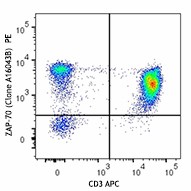
-

Human peripheral blood lymphocytes were surface stained with CD3 APC and then treated with True-Nuclear™ Transcription Factor Buffer Set. Cells were then stained with ZAP-70 (clone A16043B) PE (top) or mouse IgG1, κ PE isotype control (bottom). -

| Cat # | Size | Price | Quantity Check Availability | Save | ||
|---|---|---|---|---|---|---|
| 693503 | 25 tests | 98€ | ||||
| 693504 | 100 tests | 230€ | ||||
ZAP-70 is a 70kD protein expressed near the surface membrane of T-cells and NK cells. It is part of the intracellular signaling mechanism of the T-cell receptor, and plays integral role in T-cell signaling where it interacts with CD3-ζ to phosphorylate transmembrane protein LAT, which facilitates the binding of many signaling proteins. ZAP-70 plays a key role in the activation of T-cells, and their subsequent proliferation, differentiation, and production of cytokines in response to varied stimuli. It is used clinically as a prognostic marker helping differentiate the various types of chronic lymphocytic leukemia (CLL).
Product DetailsProduct Details
- Verified Reactivity
- Human, Mouse
- Antibody Type
- Monoclonal
- Host Species
- Mouse
- Immunogen
- Human ZAP 70 peptide phosphorylated at Y493. Complete Freund's adjuvant.
- Formulation
- Phosphate-buffered solution, pH 7.2, containing 0.09% sodium azide and BSA (origin USA)
- Preparation
- The antibody was purified by affinity chromatography and conjugated with PE under optimal conditions.
- Concentration
- Lot-specific (to obtain lot-specific concentration and expiration, please enter the lot number in our Certificate of Analysis online tool.)
- Storage & Handling
- The antibody solution should be stored undiluted between 2°C and 8°C, and protected from prolonged exposure to light. Do not freeze.
- Application
-
ICFC - Quality tested
- Recommended Usage
-
Each lot of this antibody is quality control tested by intracellular flow cytometry using our True-Nuclear™ Transcription Factor Staining Protocol.
- Excitation Laser
-
Blue Laser (488 nm)
Green Laser (532 nm)/Yellow-Green Laser (561 nm)
- Application Notes
-
CD3, CD19, and CD56 co-staining indicates that this clone does not bind B-cells and will not bind Syk. Clone A16043B cross-reacts with mouse species.
NOTE: For flow cytometric staining with this clone, True-Nuclear™ Transcription Factor Buffer Set (Cat. No. 424401) offers improved staining and is highly recommended.This clone, A16043B, recognizes both non-phosphorylated ZAP-70 and phosphorylated forms of ZAP-70.
- RRID
-
AB_2632836 (BioLegend Cat. No. 693503)
AB_2632837 (BioLegend Cat. No. 693504)
Antigen Details
- Structure
- Protein tyrosine kinase, contains two SH2 domains, 70 kD.
- Distribution
-
T cells, NK cells, and B-cell chronic lymphocytic leukemia (B-CLL).
- Function
- Signal transduction, associates with the T-cell antigen receptor zeta chain tyrosine-based activation motif when phosphorylated. Defects in ZAP70 causes selective T cell defect.
- Ligand/Receptor
- Binds to CD3 zeta chain, also associates with a variety of proteins including SLA, Fyn, RasGap, Lck, Vav1, and Shc.
- Cell Type
- T cells, NK cells, Leukemia
- Biology Area
- Cell Biology, Immunology, Signal Transduction
- Molecular Family
- TCRs
- Antigen References
-
1. Qian D, et al. 1997. J. Exp. Med. 185:1253. (ICFC)
2. Crespo M, et al. 2003. N. Engl. J. Med. 348:1764. (WB, IP)
3. Jamroziak K, et al. 2009. Cancer Epidemiol. Biomarkers Prev. 18:945. - Gene ID
- 7535 View all products for this Gene ID 22637 View all products for this Gene ID
- UniProt
- View information about ZAP-70 on UniProt.org
Related FAQs
- What type of PE do you use in your conjugates?
- We use R-PE in our conjugates.
Other Formats
View All ZAP-70 Reagents Request Custom Conjugation| Description | Clone | Applications |
|---|---|---|
| PE anti-ZAP-70 | A16043B | ICFC |
| Alexa Fluor® 488 anti-ZAP-70 | A16043B | ICFC |
| Purified anti-ZAP-70 | A16043B | ICFC |
| Alexa Fluor® 647 anti-ZAP-70 | A16043B | ICFC |
Compare Data Across All Formats
This data display is provided for general comparisons between formats.
Your actual data may vary due to variations in samples, target cells, instruments and their settings, staining conditions, and other factors.
If you need assistance with selecting the best format contact our expert technical support team.
-
PE anti-ZAP-70
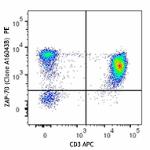
Human peripheral blood lymphocytes were surface stained with... 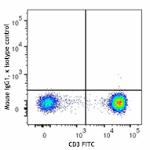
-
Alexa Fluor® 488 anti-ZAP-70
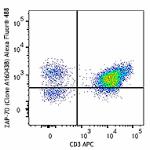
Human peripheral blood lymphocytes were surface stained with... 
-
Purified anti-ZAP-70
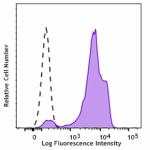
Human peripheral blood lymphocytes treated with True-Nuclear... -
Alexa Fluor® 647 anti-ZAP-70
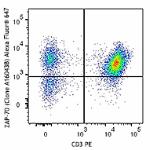
Human peripheral blood lymphocytes were surface stained with... 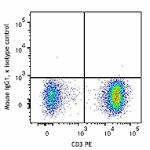
 Login / Register
Login / Register 












Follow Us